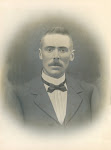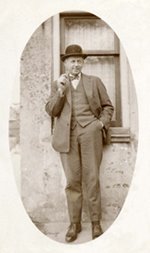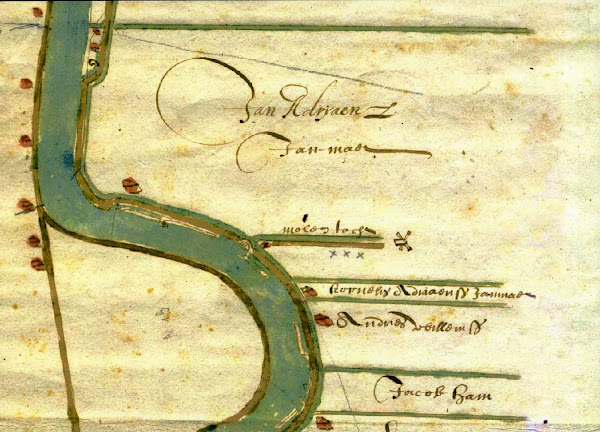 This is said to be the only known existing picture of the village church of Waddinxveen. If you look on the map of the Waddinxveen area shown further down on this blog you can see the location where this church stood until 1838, marked by a cross on the section of land between the Kerkweg (Church Road) and the Dorrekade. This version of the picture is from the book "Omme 't woort Gods" (About God's Word) by C. Neven, 1978. However, this picture, which was drawn by Anna C. Brouwer, was first published in "De Nederlandse Stad- en Dorp-Beschrijver" (A Description of Dutch Towns and Villages) by L. van Oleffen and R. Bakker, 1793
This is said to be the only known existing picture of the village church of Waddinxveen. If you look on the map of the Waddinxveen area shown further down on this blog you can see the location where this church stood until 1838, marked by a cross on the section of land between the Kerkweg (Church Road) and the Dorrekade. This version of the picture is from the book "Omme 't woort Gods" (About God's Word) by C. Neven, 1978. However, this picture, which was drawn by Anna C. Brouwer, was first published in "De Nederlandse Stad- en Dorp-Beschrijver" (A Description of Dutch Towns and Villages) by L. van Oleffen and R. Bakker, 1793Friday, June 13, 2008
The old church of Waddinxveen
 This is said to be the only known existing picture of the village church of Waddinxveen. If you look on the map of the Waddinxveen area shown further down on this blog you can see the location where this church stood until 1838, marked by a cross on the section of land between the Kerkweg (Church Road) and the Dorrekade. This version of the picture is from the book "Omme 't woort Gods" (About God's Word) by C. Neven, 1978. However, this picture, which was drawn by Anna C. Brouwer, was first published in "De Nederlandse Stad- en Dorp-Beschrijver" (A Description of Dutch Towns and Villages) by L. van Oleffen and R. Bakker, 1793
This is said to be the only known existing picture of the village church of Waddinxveen. If you look on the map of the Waddinxveen area shown further down on this blog you can see the location where this church stood until 1838, marked by a cross on the section of land between the Kerkweg (Church Road) and the Dorrekade. This version of the picture is from the book "Omme 't woort Gods" (About God's Word) by C. Neven, 1978. However, this picture, which was drawn by Anna C. Brouwer, was first published in "De Nederlandse Stad- en Dorp-Beschrijver" (A Description of Dutch Towns and Villages) by L. van Oleffen and R. Bakker, 1793A beautiful old school photo

This beautiful old photo dates back to 1910 and shows pupils from the Roman Catholic Primary School in the town of Nieuwveen.
Hendrikus Bartholomeus Janmaat (1904-1985), son of Theodorus Janmaat and Margaretha Kaptijn: located in the front row, fourth from the left.
Petronella Cecilia Maria Janmaat (1899-1982), daughter of Theodorus Janmaat and Margaretha Kaptijn: To easily locate Petronella start with the teacher on the right hand side of the picture at shoulder height and select the second girl to the left!
Hendrikus Bartholomeus Janmaat (1904-1985), son of Theodorus Janmaat and Margaretha Kaptijn: located in the front row, fourth from the left.
Petronella Cecilia Maria Janmaat (1899-1982), daughter of Theodorus Janmaat and Margaretha Kaptijn: To easily locate Petronella start with the teacher on the right hand side of the picture at shoulder height and select the second girl to the left!
The St. Nicolas Church in Nieuwveen


This view is of the Roman Catholic Sint Nicolaaskerk (St. Nicolas Church) in the town of Nieuwveen around 1895, as seen from the "Dorpsstraat" (literally: Village Street), when you enter Nieuwveen from the direction of the village of Vrouweakker. This church was first used on the 19th August 1867, however, the church tower was still missing as money was in short supply. The church and the adjoining Presbytery were built by the carpenter-contracter Henricus Janmaat (1827-1912) from Nieuwveen for the sum of 36800 Dutch Guilders.
Prior to 1865 the people of Nieuwveen did not have their own local Roman Catholic Parish. As early as 1862 an approach was made to the bishop of Haarlem to allow Nieuwveen to have their own Parish with their own Church. Permission for this was finally granted in 1865. While, as noted earlier, the church was built in 1867, the tower was not added until 20 years later in 1887. The story has it that the bishop of Haarlem came to visit Nieuwveen in 1886 but could not find the church because there was no church-tower. This apparently so embarassed the local pastor that he decided to personally finance the construction of the church-tower, at a cost of 10770 Dutch Guilders. The cost of the church-bells was to be borne by the parishioners.
The top photo shows a close up view of the St. Nicolaas Church in Nieuwveen as it was around the year 1900. Note the Presbytery on the left and the gate leading to the cemetery on the right hand side of the church.
Friday, April 18, 2008
The "Oudewater" Connection
 Oudewater is a beautiful and well maintained old city in the province of Utrecht. The above drawing is by the Dutch painter Cornelis Springer (1817-1891) and provides a view of the Town Hall of Oudewater.
Oudewater is a beautiful and well maintained old city in the province of Utrecht. The above drawing is by the Dutch painter Cornelis Springer (1817-1891) and provides a view of the Town Hall of Oudewater.In 2005 I had the opportunity to visit the city of Oudewater and to meet up with (second) cousins that I had never met before! (Hello Marja). During my visits there I was truly impressed with the overall look and feel of this old city. A lot of the old buildings, indeed whole sections of the city, look like they have not changed much during the last 200 years, but are in a good state of repair. Oudewater is important to me because it is the focus of a region where my father's father and family used to live. Over the next few months I will try and put together a special album (album #8) about Oudewater and the various families that are of interest to me there!
Thursday, April 17, 2008
Traditional Dutch Costumes: Fishing Village of Volendam

Volendam is a small fishing village on the west coast of the IJsselmeer in the province of North Holland. Today not many of its inhabitants still wear the traditional dress as shown in the picture above. However, when these Janmaats visited Volendam they took advantage of a photo opportunity, which resulted in this beautiful photo. To find out who is in the photo visit the web site of the Janmaat Family and check out Photo Album 3.
Thursday, April 3, 2008
Map of Waddinxveen around 1400
 This is probably one of the most informative maps of "Waddinxveen" that I have ever come across. It is meant to show when the various sections of what we today call Waddinxveen were first developed. It is generally accepted that Waddinxveen was 'founded' in 1233; for this see the section of land along the Gouwe south of the Dorrekade. It is also interesting to note that development in (the polder of) Bloemendaal started much earlier in 1138 as shown on the map. Another interesting observation is that the section of land between the Kerkweg and the Dorrekade belonged to Bloemendaal and not to Waddinxveen. It is said that this allowed the people from Bloemendaal (Bloemendalers), who did not have their own church, to walk to the church of Waddinxveen over their own land, apparently much to the annoyance of the people of Waddinxveen.
This is probably one of the most informative maps of "Waddinxveen" that I have ever come across. It is meant to show when the various sections of what we today call Waddinxveen were first developed. It is generally accepted that Waddinxveen was 'founded' in 1233; for this see the section of land along the Gouwe south of the Dorrekade. It is also interesting to note that development in (the polder of) Bloemendaal started much earlier in 1138 as shown on the map. Another interesting observation is that the section of land between the Kerkweg and the Dorrekade belonged to Bloemendaal and not to Waddinxveen. It is said that this allowed the people from Bloemendaal (Bloemendalers), who did not have their own church, to walk to the church of Waddinxveen over their own land, apparently much to the annoyance of the people of Waddinxveen.For more information about Waddinxveen visit the web site of the Janmaat Family and check out Album 4.
Thursday, March 27, 2008
Waddinxveen: Mills along the Zuidkade (South Quay)
 This view is taken from the river "de Gouwe" and dates back to approximately 1910. The two mills shown here were used for making paper. The one on the left is called "de Nijverheid" (Industry) and the one on the right is called "de Hoop" (Hope) Both mills were built in 1651. "de Nijververheid" was demolished in 1932 and "de Hoop" in 1911.
This view is taken from the river "de Gouwe" and dates back to approximately 1910. The two mills shown here were used for making paper. The one on the left is called "de Nijverheid" (Industry) and the one on the right is called "de Hoop" (Hope) Both mills were built in 1651. "de Nijververheid" was demolished in 1932 and "de Hoop" in 1911.
Subscribe to:
Comments (Atom)


+copy2.jpg)




.jpg)


